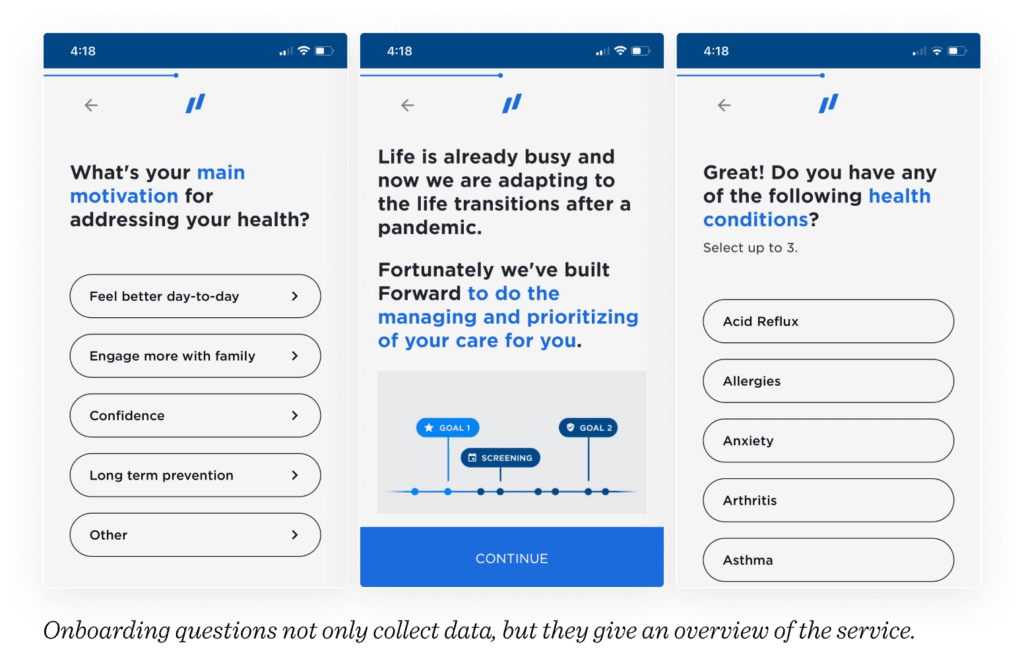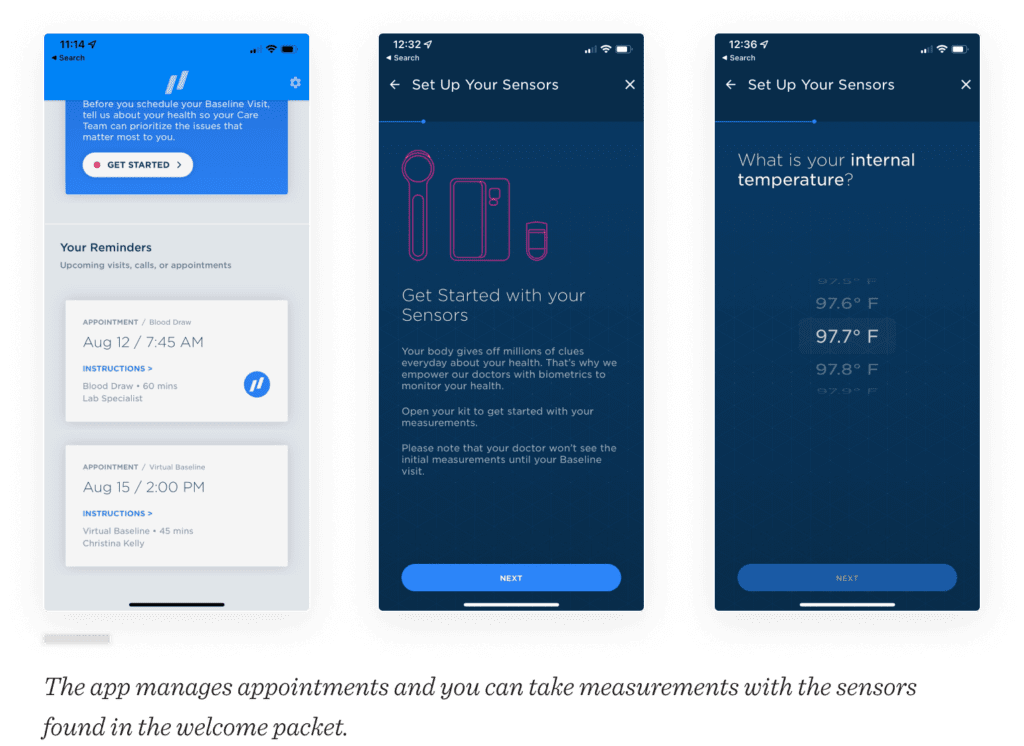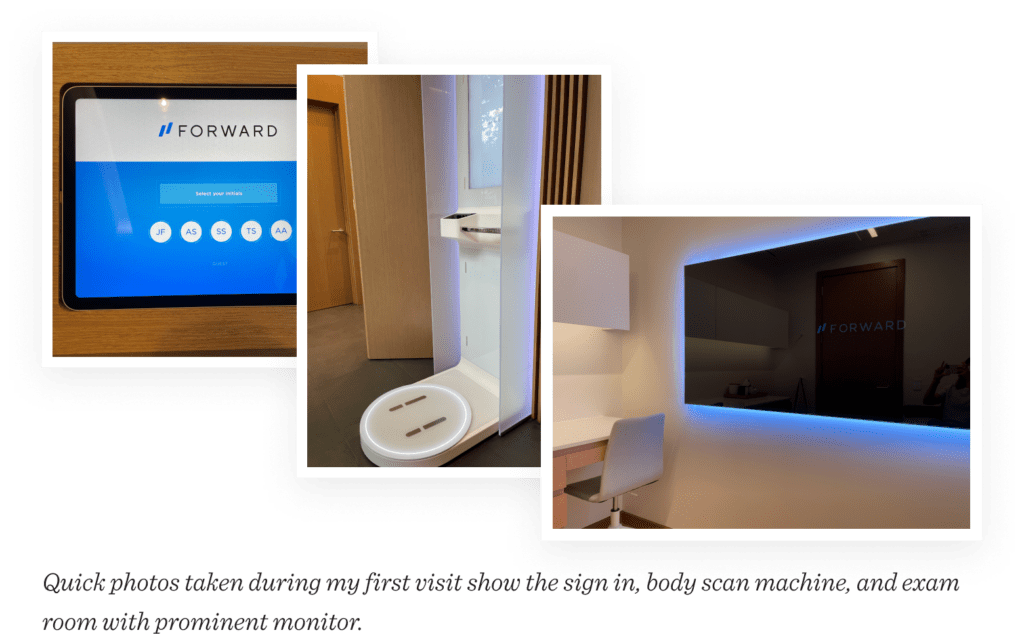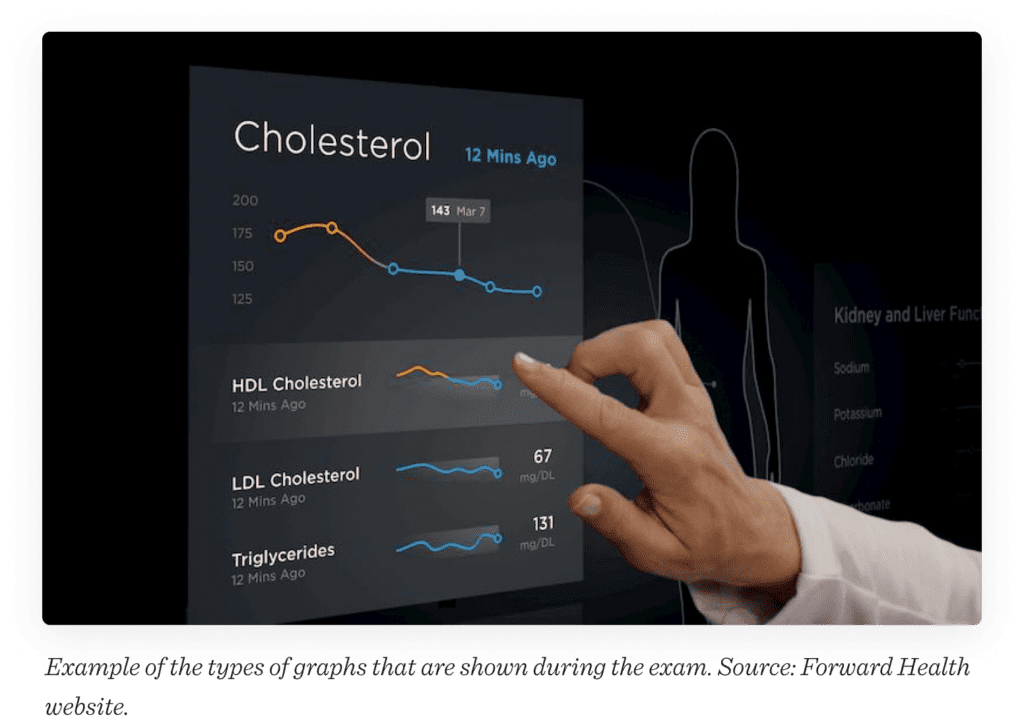Forward Health: An Evaluation of the Patient Journey From Onboarding to Offboarding
UX Deep Dives By Allison Sall ▪ May 5, 2023
If you aren’t familiar with Forward Health, they are a primary care startup focusing on preventative care. Their approach to preventative care encourages patients to make small changes to prevent illness instead of treating illness after it onsets.
They also approach patients as consumers, with a monthly membership fee promising a different healthcare experience, including longer doctor visits, personalized care, and tech-enabled solutions. So when I learned that Forward Health was opening an office in Atlanta, I was intrigued.

Personalized Healthcare is an Appealing Opportunity
I’ve been in the market for a better healthcare experience for years. I consider myself in reasonably good health; I work out, eat leafy greens, and try to keep my stress low.
However, three years ago, I had blood work completed during a routine doctor’s visit. A few days later, I received an email with my results that announced that I had high cholesterol. The email included a series of numbers out of context (my levels) and generic advice to eat less meat and more grains and vegetables.
At its best, the email was generic. If the doctor had asked me, she might have discovered that, as a vegetarian, I was already eating grains and vegetables. That experience made me long for a more personalized healthcare experience that didn’t leave me in a Google gap to search the internet for answers.
When Forward Health offered a discount to try the membership for six months – I was sold.
Onboarding: An Efficient Digital Experience Resulted in Some Service Point Friction
To sign up for Forward, I downloaded the app and answered a lengthy questionnaire about my personal and family health history. The depth of the questions made it feel personalized, and I liked that it was building a health profile for me. A centralized health history that I could refer to seemed helpful beyond my doctor visits.

Forward differs from a traditional healthcare model because they gather blood work before your initial clinical visit. This approach removes the need for multiple visits in one efficient swoop.
Their app made booking the two appointments for an at-home phlebotomist and my follow-up doctor’s visit easy. I was pleasantly surprised at the convenience of scheduling a phlebotomist to visit me in the comfort of my home. The app advised me to fast before the blood work. Since I love to eat, I booked an early morning appointment.
On the day of my appointment, I dutifully skipped breakfast and waited. An hour after my scheduled time, I was still waiting for the phlebotomist to arrive. I messaged Forward’s support team in the app, and after another hour and some back and forth, they offered to schedule an in-person visit at the new Atlanta office. In this in-person appointment, they would do both the blood work and the clinical visit in one session.

Around the same time, I received a welcome box in the mail from Foward. The box contained a blood pressure monitor, thermometer, and finger pulse oximeter. I wasn’t sure if I would need to monitor myself regularly or not, but it felt like a nice gesture to initiate my health journey with Forward.
Positive points:
- A centralized health profile
- Ability to schedule multiple appointments at once
- An overview of what I should expect from my appointments with tips for fasting
- Welcome packet to mark the beginning of a journey
Friction points:
- The no-show appointment and lack of communication
- Could set more clear expectations on how the welcome packet would be used
The First Visit: A Differentiated Healthcare Experience
I arrived early and walked into the clean white space I recognized from the website. Instead of chairs or a reception desk in the lobby, there was a machine with an airplane-like aesthetic and an iPad. The iPad encouraged me to sign in with only my initials, AS. This made it simple but also reinforced my privacy. There were no forms to fill out since I’d already done that in the app.

A member from Forward emerged to guide me to step on the machine and stick my hand in a cuff. The machine weighed me and checked my temperature, pulse, and blood pressure. The experience felt futuristic, but I reflected that I could do the same measurements with the welcome kit they sent me.
Next, they led me into an exam room, where I sat in a comfortable chair that faced a large monitor. They gave me an overview of my visit:
- First, I’d have my blood drawn by a nurse
- Then, the physician would ask me questions
- And finally, we’d discuss my results
The visit would take about an hour. An hour with a physician is unheard of – fulfilling the promise of more extended visits. In addition, the overview of the experience ensured that at each point, I knew what to expect next.
Just as they promised, the visit ran like clockwork. The blood draw was quick, and the nurse was attentive. She offered me a snack since she knew I’d been fasting, a thoughtful detail. Next, the physician introduced herself and asked me more extensive questions about my family history.
Once my blood results were processed, she pulled them up on the monitor. A few taps on the screen revealed line graphs of my levels. The visualized results showed how my numbers compared to a normal or goal range.

At the end of the visit, she asked me to pick 3 areas I would like to focus on in my health journey. This touchpoint put me in control and gave me a concrete way to improve my health. Next, she told me I would test my DNA with a 23andMe kit to look for potential health risks. I left my appointment feeling energized and motivated.
Positive points:
- A clear overview of the visit and what to expect next on the health journey
- Visit efficiency, no forms to fill out or extra visits
- Visual graphs demonstrate my data in context
- Extended time with the physician
- Actionable health journey next steps
Post-Visit: Communication Missteps Led to a Disjointed Service Experience
Following my visit, when I opened the app, I saw my results with the same graphic line charts I reviewed with the physician. The next steps were clear:
- Schedule additional exams with specialists.
- Focus on my diet.
- Take the DNA test.
I had a plan of action!
About a week after I visited Forward, I started getting messages in the app that instructed me to upload my DNA results. However, I was confused because I hadn’t received the DNA kit to take the test.
I realized then that the team you communicate with while using the app differs from your health team, and there are often lags between getting answers. For example, it took a little over a month for the DNA kit to arrive. Meanwhile, I became increasingly annoyed with the insistent messages that asked me to upload my results and follow up on my appointments.
By the time the DNA kit arrived, I’d lost my momentum. It was the holidays, and my focus had turned to my family and holiday events. Since completing the DNA test and scheduling my next appointment was on me, I let it slip.
Before I knew it, I noticed the membership charge had increased. I messaged the team, who informed me that my discounted rate had expired and I was now on the full-priced plan. I was disappointed that I wasn’t notified of the increase before it happened. After 6 months, I wasn’t getting much value of the service since my first visit. Like any unused membership, I had to cancel.
Canceling was easy. But when I opened the app again, I no longer had an account, and my health record and charts were gone. After emailing the team, they sent a text file devoid of history or graphs. If the offboarding experience had been as good as the onboarding, I might have recommended it more.
Positive points:
- A clear health plan
- Charts are easy to reference and accessible in the app
Friction points:
- Reminders felt more harassing than helpful
- Long wait times created a loss in momentum
- Communication failed to notify me of a price increase
- Ending my membership didn’t include my data
Principles for a Better Health Experience
While no service gets all the touchpoints perfectly, Forward Health is a massive leap in the right direction. Their patient experience feels more like a consumer experience than a traditional model. They’ve attempted to reduce the inefficiencies of a conventional healthcare model with the app; however, they’ve created new challenges in doing so. Forward Health could be a great option if I were seriously monitoring a health issue. But, unfortunately, it wasn’t the solution for my needs.
The best takeaways from my patient journey:
Anchor the health journey.
Provide an overview so the patient always knows where they are and what to expect next.
Reduce inefficiencies.
Use digital tools to reduce the need to fill out multiple forms, schedule appointments, and keep track of essential data points.
Connect the digital and physical experiences.
The digital experience and physical experience should be in lockstep, from the graphs on the monitors to the graphs in your pocket.
Proactive guidance
Keep the momentum going by creating focus areas, scheduling the next appointment before they go, and creating little ways they can feel in charge of their health.
Tinker & Explore: UX Evaluations of New Products & Services
At Everyday Industries, we’re curious about how new technologies and services shape our experience of the world. So, we created a program called ‘Tinker & Explore,’ where we experience and evaluate new products or services through a UX lens.
Past evaluations include:
- WHOOP Health & Fitness Wearable: A band that tracks fitness and sleep data to provide recommendations for optimizing performance, sleep, and overall well-being.
- Ray-Ban Stories Smart Glasses: Eyewear with integrated technology, allowing users to capture photos and videos, listen to music, make phone calls, and access various other features directly from the glasses.
- Levoit Air Purifier, Humidifier & VeSync App: Smart home products that connect to an app allowing you to monitor and manage your home’s air quality and humidity.
We use these UX evaluations to be thoughtful about experience design. We are always open to feedback and would love to have a conversation, so don’t hesitate to contact us if you have any questions.





